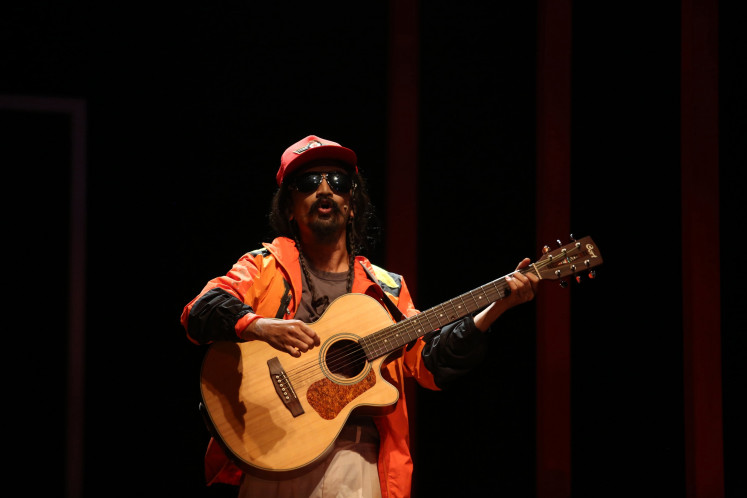Popular Reads
Top Results
Can't find what you're looking for?
View all search resultsPopular Reads
Top Results
Can't find what you're looking for?
View all search results'Panggil Aku Gombloh’ unearths the legendary musician’s loves and dreams
A series of new monologues tells the story of Gombloh, an Indonesian musical icon.
Change text size
Gift Premium Articles
to Anyone
A series of new monologues tells the story of Gombloh, an Indonesian musical icon.
Those who grew up in Indonesia in the 1980s would likely be familiar with some of the era’s most iconic songs, such as “Lestari Alamku” (Sustainable Nature, 1982), “Sekar Mayang” (1984), “Apel” (Dating, 1987), as well as the thin, long-haired and thickly mustachioed man who sang them with his throaty voice while belting the tunes on his guitar.
Gombloh (1948-1988) is a legendary figure in Indonesia’s music industry. The singer and songwriter, whose given name was Soedjarwoto, lived a short, yet memorable life (he died at 39 years of age). His songs, which are still on heavy rotation, express his ideals and patriotism.
In 2005, approximately 17 years after his passing, the Association of Indonesian Artists, Music Arrangers and Songwriters (PAPPRI) awarded Gombloh with the Nugraha Bhakti Musik Indonesia for his dedication to the country’s music.
On April 27-28, Titimangsa, a non-profit organization in performing arts, presented the singer’s life story in a monologue, “Panggil Aku Gombloh” (Call Me Gombloh) in Gedung Kesenian, Central Jakarta (GKJ).
“Many of us recognize Gombloh’s works, but perhaps not his life story,” Pradetya Novitri, Titimangsa’s project manager and coproducer of the monologue, said during an interview at GKJ on April 27. “He’s such an iconic character. In his own way, Gombloh fought hard for his idealism and nationalism.”
Wanggi
Well-known mime artist Wanggi Hoediyatno was assigned the main role in the monologue.
“[The role] is quite challenging for me, especially as I haven’t spoken in any of my performances for more than 15 years,” the mime artist said, with a smile, during the interview after his performance on April 27.
Born in Cirebon, West Java, in 1988, Wanggi resembles the late artist in both his physique and idealism.
Like Gombloh, the mime artist is also tall and lanky and wears a thick, horseshoe mustache. Wanggi also actively participates in a number of independent creative communities, such as Mixi Imajimimetheater Indonesia, Nyusur History Indonesia and the Indonesian Mime Artists Association.
In 2013, the mime artist also collaborated with French theatrical troupe Compagnie Chabatz d’Entrar and performed in nine cities in Indonesia, Timor Leste and Vietnam.
“I was born in the same year as Gombloh’s passing,” Wanggi said. “But I know all his songs by heart. Therefore, it’s an honor for me to have been chosen to perform in this monologue.”
Wanggi trained long and hard for his role under the director Joind Bayuwinanda.
“Wanggi’s fasting, but we made him get up early, exercise and practice his vocals for the monologue,” the director said.
Bleki
As GKJ’s curtain was raised for the performance on April 27, Gombloh was portrayed to be sleeping in a gazebo at the center of the stage, with his back facing the audience. Suddenly, the song “Kugadaikan Cintaku” (Pawning My Love, 1986) blared from the radio next to his head. Cursing, the singer immediately got up and turned the radio off, saying, “All artists are surely like me, hating their own works.”
Wanggi then went on narrating Gombloh’s poverty during his early career.
“My own wife called me ‘Bleki’ [a common name in Indonesia for a dog], as I couldn’t even afford to buy rice for my family,” he said, with a dry laugh.
In order to please his wife, the singer then pawned his idealism and obeyed the biddings of record companies to write cheesy love songs that sell.
For the performance, GKJ’s stage was divided into three parts — left, center and right — and embellished with oversized hanging frames in various colors and sizes.
“We’d wanted to set up a more detailed set, but the stage manager had envisioned something simpler, yet more dramatic with these hanging frames,” Joind, the director, said. “Each frame seems to represent a phase in Gombloh’s life.”
Contemplating: In this scene, Gombloh is ruminating on his success as a 'pop star'. (Courtesy of Titimangsa) (Courtesy of Titimangsa/Courtesy of Titimangsa)Wiwiek
The second part of the monologue features Gombloh’s love story with his wife, Wiwiek. After meeting the young woman in a concert in Blitar, East Java, in the early 1980s, the singer fell in love and brought her to his home in Surabaya.
Wiwiek’s father was enraged and took her back. He also demanded the singer come to Blitar to properly ask for her hand in marriage.
The poor singer then borrowed Rp 10,000 (US$0.68) from a friend to marry Wiwiek.
There are so many interesting facts about Gombloh revealed during the monologue.
“Our scriptwriter, [Guruh] Dimas [Nugraha], is very well-versed in almost every aspect of Gombloh’s life,” Joind said. “He’s even written a book about him.”
Loni
Daun-daun jati terlepas-lepas (Leaves are falling off from the teak trees)
Terbang melayang satu di badannya (One of them drops on her body)
These poetic lyrics from Gombloh’s ballad “Loni, Pelacur & Pelacurku” (Loni, Prostitute & My Prostitute, 1979) reverberated onstage as Gombloh was seen sorting out women’s lingerie in various colors and sizes in the gazebo.
The third part of the monologue focuses on Gombloh’s relations with numerous prostitutes in Dolly, a former prostitution complex in Surabaya.
Gombloh originally went there in search of new inspiration for his songs.
“But you know men,” Joind said, with a laugh. “You know, how men behave when surrounded by women in a prostitution complex.”
Gombloh indeed wrote a lot of poignant ballads, such as “Loni, Pelacur & Pelacurku” and “Doa Seorang Pelacur” (Prayer of a Prostitute, exact year unknown), in the prostitution complex.
Martin Hatch, a professor of Cornell University, also wrote about Gombloh’s songs in his study, “Social Criticism in the Songs of 1980’s Indonesian Pop Country Singers,” in 2000.
Gombloh did not only take his inspiration from Dolly’s prostitutes, but also put his heart among them.
“He had a dream, which I think is so impossible, to abolish prostitution in Indonesia,” Joind disclosed. “Was the man crazy or what? But that’s Gombloh. He’s just incredible.”
During his success in Indonesia’s music industry, Gombloh shared a large part of his earnings to help some of the prostitutes in Dolly return home and start a new, better life. The initiative was part of Gombloh’s Revolusi Cinta (Love Revolution) movement.
But unfortunately, the singer did not live very long. He died at 39 due to a lung disease.
“At the end of his life, I think Gombloh has only realized 5 percent of all his dreams,” Joind said. “But that’s already something.”
Gombloh’s most famous song “Kebyar Kebyar” (1979) was playing as GKJ’s curtain was being lowered to conclude the 45-minute monologue. Rolling Stone Indonesia named this patriotic song among the 150 Best Indonesian Songs of All Time in 2009.
His dream: A scene where Gombloh is reiterating his goal to alleviate the sufferings of all prostitutes in Dolly. (Courtesy of Titimangsa) (Courtesy of Titimangsa/Courtesy of Titimangsa)Indonesiana
The monologue is part of the “Di Tepi Sejarah” (On the Edge of History), a series of monologues on Indonesian historical figures by Titimangsa and Ahmad Mahendra, the director of film, music and new media in the Education, Culture, Research and Technology Ministry.
“There are a lot of awe-inspiring men and women in our history that today’s young people might not know,” said Ahmad. “Hopefully, these monologues can help re-introduce these almost-forgotten historical figures to today’s youth.”
The recording of “Panggil Aku Gombloh” will be streamed on Indonesiana TV, an omnichannel platform run by the Education, Culture, Research and Technology Ministry, in August.
“By streaming the program on Indonesiana TV, we hope to facilitate an encounter between today’s young people and Indonesia’s iconic historical figures,” Yulia Evina Bhara, coproducer of the monologue, said.
In June, Titimangsa and Ahmad will also feature the life story of Indonesian painter Emiria Soenassa in a monologue.














